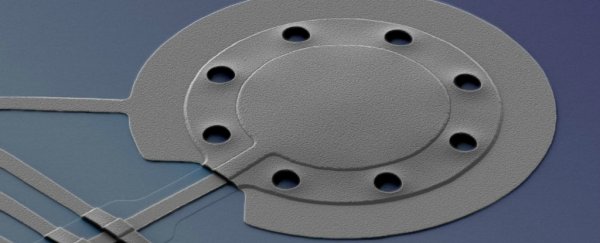For the first time, physicists have cooled a mechanical object to a temperature colder than previously thought possible, taking it below the so-called "quantum limit" and bending the laws of physics.
Using a new technique, the team managed to chill a microscopic mechanical drum to an unheard-of 360 microKelvin, or 10,000 times colder than the vacuum of space. It's the coldest mechanical object on record.
"It's much colder than any naturally occurring temperature anywhere in the Universe," team leader John Teufel from the US National Institute of Standards and Technology in Boulder, Colorado, told Leah Crane from New Scientist.
"The results were a complete surprise to experts in the field," added one of the researchers, José Aumentado, in a press release.
To be clear, this isn't the coldest object ever - that title goes to Bose-Einstein condensates. Bose-Einstein condensates are a dilute gas of bosons that can be cooled to temperatures as cold as 500 picoKelvin (a picoKelvin is 10–12 and a microKelvin is 10–6).
But this is by far the coldest mechanical object, which means it's part of a bigger set-up and could be used in future technology.
The tiny drum was made up of a vibrating aluminium membrane - and the researchers were able to take it to less than one-fifth of a single 'quantum' lower than the laws of physics predict that temperatures can get. A quantum is used to describe a single packet of energy contained in a photon.
In fact, the team suggests the new technique is so powerful, it could theoretically be used to cool objects to absolute zero, or zero Kelvin - the temperature at which matter is devoid of nearly all energy and motion.
Usually when researchers cool down objects, they use lasers to slow down the motion of atoms, which dampens the thermal vibrations occurring in a material.
The more organised laser light is, the better it can cool a surface down. But the new technique takes things one step further - and uses something called 'squeezed' light to get atoms much colder than was previously thought possible.
Squeezed light is a type of light that's been more organised in one direction compared to another. This moves unnecessary quantum noise - or fluctuations - in the light particles, from a useful property of the light to another aspect that doesn't affect the experiment.
This squeezed light is frequently used in quantum cryptography and to entangle light. But this is the first time that researchers had thought to apply it to cool something down.
That's a big deal, because the noise in normal organised light heats up any object that researchers are trying to cool, and limits how cold it can get - hence the 'quantum limit'.
But the new study suggests that by squeezing light, we can smash through that quantum cooling limit.
"Noise gives random kicks or heating to the thing you're trying to cool," said Teufel.
"We are squeezing the light at a 'magic' level - in a very specific direction and amount - to make perfectly correlated photons with more stable intensity. These photons are both fragile and powerful."
Why does it matter how cold we can make materials? Because it could help us create the super-fast electronics of the future.
The drum instrument that the team cooled down was 20 micrometres in diameter and 100 nanometres thick, and was embedded in a superconducting circuit.
This type of drum could be used in quantum computers that combine quantum and mechanical elements, and the colder you can get it, the more accurate it will be.
"The colder you can get the drum, the better it is for any application," said Teufel.
"Sensors would become more sensitive. You can store information longer. If you were using it in a quantum computer, then you would compute without distortion, and you would actually get the answer you want."
The super-chilled drum could also help us probe the very nature of the quantum world, seeing as some of the strange behaviours of quantum mechanics seem to emerge in regular materials once they reach the limits of what was previously thought to be physically possible.
As we're learning, what we think is possible now is just the beginning when it comes to science.
The research has been published in Nature.
